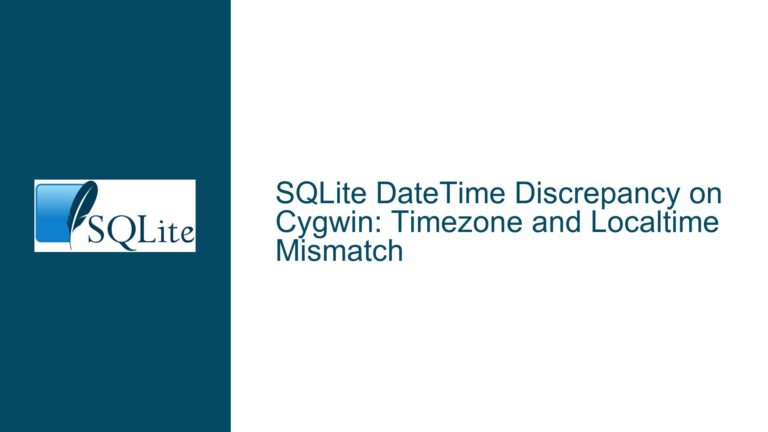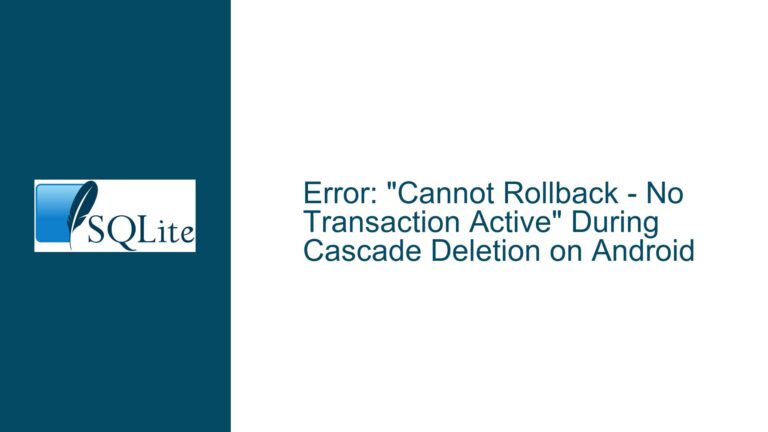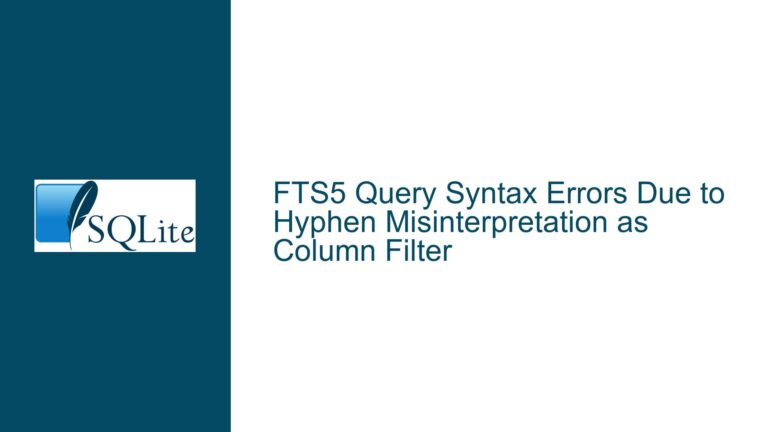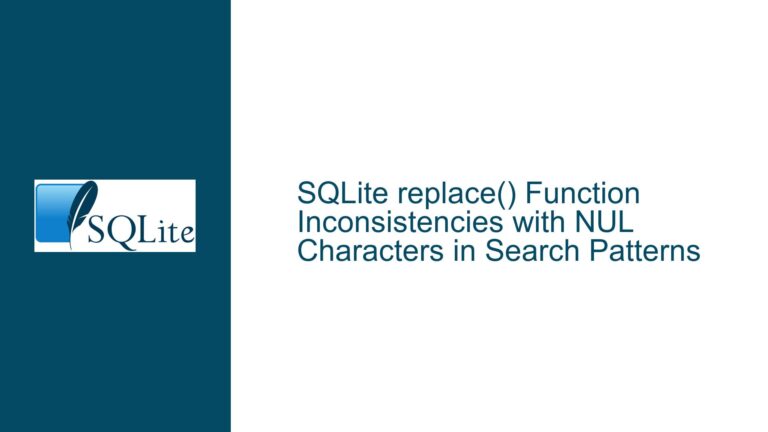Detecting Overlapping Geographic Bounding Boxes in SQLite: Query Strategies and Edge Cases
Understanding Bounding Box Overlap Detection in SQLite
Geographic bounding boxes are rectangular regions defined by four coordinates: minimum and maximum longitude (east-west) and latitude (north-south). In the context of SQLite, these boxes are stored as rows in a table, with each row representing a distinct geographic area. The core challenge lies in efficiently identifying overlapping boxes when longitude values wrap around a 0–360° range (common in planetary mapping) and latitude spans between -90° and 90°. Overlap detection requires comparing two boxes’ coordinate ranges to determine if they intersect on both axes.
A bounding box is defined by its upper-left (minimum longitude, maximum latitude) and lower-right (maximum longitude, minimum latitude) coordinates. For example, a box with UPPER_LEFT_LONGITUDE=347.15, UPPER_LEFT_LATITUDE=-36.545832, LOWER_RIGHT_LONGITUDE=348.38, and LOWER_RIGHT_LATITUDE=-40.735216 spans from 347.15°E to 348.38°E in longitude and -40.735216° to -36.545832° in latitude. Overlap occurs when two boxes share at least one point in common. Mathematically, this requires:
- The longitude range of Box A overlaps with the longitude range of Box B.
- The latitude range of Box A overlaps with the latitude range of Box B.
Longitude wrapping complicates overlap detection. For instance, a box spanning 350°E to 10°E (crossing the 360°/0° boundary) must be treated as two segments: 350°E–360°E and 0°E–10°E. Latitude does not wrap, simplifying its overlap logic.
Key considerations include:
- Coordinate System Assumptions: The dataset uses aerocentric latitude (planetocentric) and east-positive longitude (0–360°). This differs from Earth’s -180° to +180° system, requiring modulo operations to handle wrapping.
- Spatial Indexing: Without proper indexing, overlap detection requires a full table scan (O(N²) complexity), which is inefficient for large datasets.
- Edge Cases: Boxes that touch at edges, boxes entirely contained within others, and boxes spanning the 360°/0° longitude boundary.
Challenges in Implementing Overlap Queries and Common Pitfalls
Longitude Wrapping and Modulo Arithmetic
When a box’s longitude range crosses the 360°/0° boundary (e.g., 350°E to 10°E), direct comparisons fail. For example, a naive query checking BoxA.min_lon <= BoxB.max_lon AND BoxA.max_lon >= BoxB.min_lon would incorrectly conclude that 350°E–10°E does not overlap with 5°E–15°E. To resolve this, longitude values must be normalized using modulo 360. However, SQLite’s % operator behaves unexpectedly with negative numbers, requiring explicit adjustments:
-- Normalize longitude to 0–360 range
CASE
WHEN longitude < 0 THEN longitude + 360
ELSE longitude
END
Latitude Boundary Checks
Latitude ranges are straightforward since they do not wrap. Overlap occurs if:
BoxA.min_lat <= BoxB.max_lat AND BoxA.max_lat >= BoxB.min_lat
However, polar regions (near -90° or +90°) require special attention if the coordinate system allows boxes to extend beyond these limits.
Performance Bottlenecks
A self-join query without spatial indexing will compare every pair of rows, leading to prohibitive execution times for large tables. For example:
SELECT a.id, b.id
FROM boxes a, boxes b
WHERE a.id != b.id
AND (
(a.min_lon <= b.max_lon AND a.max_lon >= b.min_lon)
OR
(a.min_lon - 360 <= b.max_lon AND a.max_lon - 360 >= b.min_lon)
OR
(a.min_lon + 360 <= b.max_lon AND a.max_lon + 360 >= b.min_lon)
)
AND (a.min_lat <= b.max_lat AND a.max_lat >= b.min_lat);
This query accounts for longitude wrapping but performs a full table scan.
Misuse of Spatial Extensions
SQLite’s R-Tree and Geopoly extensions provide optimized spatial indexing, but they require schema adjustments. For instance, R-Tree virtual tables store bounding boxes as minimum/maximum coordinates, while Geopoly uses polygon representations. Failing to normalize coordinates before using these extensions will produce incorrect results.
Efficient Solutions Using R-Tree, Geopoly, and Custom SQL Logic
Solution 1: R-Tree Extension for Spatial Indexing
- Create an R-Tree Virtual Table:
CREATE VIRTUAL TABLE boxes_rtree USING rtree( id, -- Primary key min_lon, max_lon, min_lat, max_lat ); - Populate the R-Tree Table:
INSERT INTO boxes_rtree SELECT id, MIN(UPPER_LEFT_LONGITUDE, LOWER_RIGHT_LONGITUDE) AS min_lon, MAX(UPPER_LEFT_LONGITUDE, LOWER_RIGHT_LONGITUDE) AS max_lon, MIN(UPPER_LEFT_LATITUDE, LOWER_RIGHT_LATITUDE) AS min_lat, MAX(UPPER_LEFT_LATITUDE, LOWER_RIGHT_LATITUDE) AS max_lat FROM original_table; - Query Overlapping Boxes:
SELECT a.id, b.id FROM boxes_rtree a, boxes_rtree b WHERE a.id < b.id -- Avoid duplicate pairs AND a.min_lon <= b.max_lon AND a.max_lon >= b.min_lon AND a.min_lat <= b.max_lat AND a.max_lat >= b.min_lat;Edge Case Handling: For longitude wrapping, expand the query to check normalized coordinates:
SELECT a.id, b.id FROM boxes_rtree a, boxes_rtree b WHERE a.id < b.id AND ( (a.min_lon <= b.max_lon AND a.max_lon >= b.min_lon) OR (a.min_lon <= b.max_lon + 360 AND a.max_lon >= b.min_lon + 360) OR (a.min_lon <= b.max_lon - 360 AND a.max_lon >= b.min_lon - 360) ) AND a.min_lat <= b.max_lat AND a.max_lat >= b.min_lat;
Solution 2: Geopoly Extension for Polygon Overlaps
- Enable Geopoly:
Load the Geopoly extension in SQLite. - Convert Boxes to Polygons:
Add ageopolycolumn to the table, storing each box as a polygon:ALTER TABLE original_table ADD COLUMN geopoly TEXT; UPDATE original_table SET geopoly = json_array( UPPER_LEFT_LONGITUDE, UPPER_LEFT_LATITUDE, UPPER_RIGHT_LONGITUDE, UPPER_RIGHT_LATITUDE, LOWER_RIGHT_LONGITUDE, LOWER_RIGHT_LATITUDE, LOWER_LEFT_LONGITUDE, LOWER_LEFT_LATITUDE, UPPER_LEFT_LONGITUDE, UPPER_LEFT_LATITUDE ); - Query Overlaps:
SELECT a.id, b.id FROM original_table a, original_table b WHERE a.id < b.id AND geopoly_overlap(a.geopoly, b.geopoly);Longitude Wrapping: Use
geopoly_bboxto normalize coordinates:SELECT a.id, b.id FROM original_table a, original_table b WHERE a.id < b.id AND geopoly_overlap( geopoly_bbox(a.geopoly), geopoly_bbox(b.geopoly) );
Solution 3: Custom SQL with Modulo Adjustments
- Normalize Longitudes:
Create a view with normalized coordinates:CREATE VIEW normalized_boxes AS SELECT id, CASE WHEN UPPER_LEFT_LONGITUDE < 0 THEN UPPER_LEFT_LONGITUDE + 360 ELSE UPPER_LEFT_LONGITUDE END AS min_lon, CASE WHEN LOWER_RIGHT_LONGITUDE < 0 THEN LOWER_RIGHT_LONGITUDE + 360 ELSE LOWER_RIGHT_LONGITUDE END AS max_lon, UPPER_LEFT_LATITUDE AS max_lat, LOWER_RIGHT_LATITUDE AS min_lat FROM original_table; - Check Overlaps with Wrapping:
SELECT a.id, b.id FROM normalized_boxes a, normalized_boxes b WHERE a.id < b.id AND ( (a.min_lon <= b.max_lon AND a.max_lon >= b.min_lon) OR (a.min_lon - 360 <= b.max_lon AND a.max_lon - 360 >= b.min_lon) OR (a.min_lon + 360 <= b.max_lon AND a.max_lon + 360 >= b.min_lon) ) AND a.min_lat <= b.max_lat AND a.max_lat >= b.min_lat; - Count Overlaps per Row:
SELECT a.id, COUNT(b.id) AS overlap_count FROM normalized_boxes a JOIN normalized_boxes b ON a.id != b.id AND ( (a.min_lon <= b.max_lon AND a.max_lon >= b.min_lon) OR (a.min_lon - 360 <= b.max_lon AND a.max_lon - 360 >= b.min_lon) OR (a.min_lon + 360 <= b.max_lon AND a.max_lon + 360 >= b.min_lon) ) AND a.min_lat <= b.max_lat AND a.max_lat >= b.min_lat GROUP BY a.id HAVING overlap_count > 0;
Indexing for Performance
- Create Composite Indexes:
CREATE INDEX idx_boxes ON normalized_boxes (min_lon, max_lon, min_lat, max_lat); - Partial Indexes for Longitude Wrapping:
CREATE INDEX idx_min_lon ON normalized_boxes (min_lon); CREATE INDEX idx_max_lon ON normalized_boxes (max_lon);
Edge Case Validation
- Exact Edge Touching:
Boxes that touch at edges (e.g., Box A’s max_lon = Box B’s min_lon) are considered overlapping. Adjust queries with<=and>=instead of strict inequalities. - Polar Boxes:
Boxes spanning latitudes beyond -90° or +90° should clamp values to these limits. - Zero-Area Boxes:
Exclude invalid boxes wheremin_lon = max_lonormin_lat = max_lat.
Integration with Python and Pandas
After executing the SQL query, use sqlite3 and pandas to fetch results:
import sqlite3
import pandas as pd
conn = sqlite3.connect('boxes.db')
df = pd.read_sql_query("""
SELECT a.id, COUNT(b.id) AS overlaps
FROM normalized_boxes a
JOIN normalized_boxes b ON a.id != b.id
AND (
(a.min_lon <= b.max_lon AND a.max_lon >= b.min_lon)
OR
(a.min_lon - 360 <= b.max_lon AND a.max_lon - 360 >= b.min_lon)
OR
(a.min_lon + 360 <= b.max_lon AND a.max_lon + 360 >= b.min_lon)
)
AND a.min_lat <= b.max_lat
AND a.max_lat >= b.min_lat
GROUP BY a.id
HAVING overlaps > 0;
""", conn)
Final Recommendations
- Use R-Tree for Large Datasets: It provides O(log N) search complexity.
- Validate Coordinate Normalization: Ensure all longitudes are in 0–360° before indexing.
- Benchmark Queries: Compare execution times of R-Tree, Geopoly, and custom SQL approaches.
By addressing coordinate normalization, spatial indexing, and edge cases, overlap detection in SQLite becomes both efficient and accurate.






